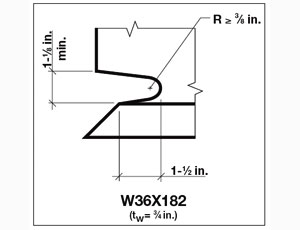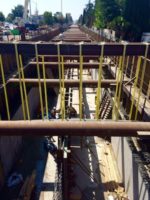Writers of standards—both for general structural design and, in particular, structural steel design—rolled out their 2010 versions this month, completed in time to be referenced in the upcoming 2012 edition of the model “International Building Code.” An overriding goal, say the engineers responsible for the revisions, is to make the standards simpler to understand and use.

The major editorial change to ASCE/SEI 7-10 “Minimum Design Loads for Buildings and Other Structures” from the 2005 standard is a “complete” reorganization into a multiple-chapter format—first introduced for seismic loads in 2005. The objective is to make the provisions “easier to follow,” said Ronald A. Cook, a professor of civil engineering at the University of Florida, Gainesville, and chairman of the subcommittee on wind loads for the standard, published by the American Society of Civil Engineers and its Structural Engineering Institute, Reston, Va.
For the three documents published by the Chicago-based American Institute of Steel Construction, the most significant difference compared to earlier versions is noticeably fewer changes. “We wanted to respect the message from designers that they can’t absorb lots of changes,” said Charles J. Carter, AISC’s chief structural engineer, at the 2010 North American Steel Construction Conference, held May 12-15 in Orlando. NASCC met for the first time in conjunction with ASCE/SEI’s Structures Congress and the Council of American Structural Engineers (CASE) Spring Risk Management Convocation. The combined conference drew 3,685 registrants, making it the second-largest conference in NASCC’s history.
The most significant change to the 2010 AISC Specification for Structural Steel Buildings (AISC 360-10) is the addition of a chapter on quality control and assurance, Carter said. The chapter provides a complete, explicit and detailed approach to quality in wind and low-seismic applications, he said. “It is structured and measured to let good companies excel, catch bad ones and do both without needlessly adding cost,” he added. “Simply put, the steel [sector] has come to the table with an unprecedented offer to improve quality.”
| REORGANIZED Wind provisions in ASCE/SEI 7-10 are in multiple chapters. |
| MAPPED New wind-speed maps for wind loads are in ASCE/SEI 7-10. |
| SIMPLIFIED ASCE/SEI 7-10 has simplified procedures for buildings up to 160 ft tall. |
| MOTION New ground-motion maps for seismic design are in ASCE/SEI 7-10. |
| PERFORMANCE ASCE/SEI 7-10 has a new performance-based design alternative. |
| SEPARATION Seismic provisions in ASCE/SEI 7-10 include building separations. |
| ADOPTION ASCE/SEI 7-10 has adopted the concrete standard, ACI 318. |
The biggest change to the 2010 AISC Seismic Provisions for Structural Steel Buildings (AISC 341-10) is a reorganization for greater consistency and cohesiveness with AISC 360. In the 2005 edition, requirements for structural steel systems were separated from those for composite structural steel-reinforced concrete systems. In the new edition, all similar systems are grouped regardless of whether they are structural steel or composite. In addition, each structural system is presented in a way that will ease comparison of requirements between systems. The result is a shorter document that is easier to understand, said Carter.
The greatest change to the 2010 AISC Code of Standard Practice for Structural Steel Buildings and Bridges (AISC 303-10) is the inclusion of a decades-old practice of engineer-of-record-delegated connection design work to a professional engineer hired by the steel fabricator. AISC partnered with the guidelines committee of CASE to develop the controversial Section 3.1.2 revision. “All parties can control their own risks, and no party is asked to assume the responsibility for the negligence of another party,” said Carter.
The fundamental technical change to seismic design provisions of ASCE/SEI 7-10 relate to new maps for “risk-targeted” maximum-considered- earthquake ground-motion-response acceleration, said John D. Hooper, director of earthquake engineering for Magnusson Klemencic Associates, Seattle, and chairman of the standard’s seismic subcommittee.
The seismic standard also includes requirements for separation between buildings and requirements for maximum anticipated drifts for members spanning between buildings. There are also new provisions and formulations for structural walls and their anchorage.
| QUALITY AISC 360 has a new chapter on quality control and assurance. |
| ALIGNMENT AISC 341 and AISC 360 standards are aligned for consistency. |
| CONNECTIONS Design by a fabricator’s professional engineer is recognized. |
Another addition to ASCE/SEI 7-10 is a performance-based design alternative. ASCE/SEI 7-10 also has adopted the National Fire Protection Association standard on fire sprinklers and the Rack Manufacturers Institute’s standard on design of steel storage racks. Finally, ASCE/SEI has adopted ACI 318-08, the major concrete design standard published by the American Concrete Institute.
Technical changes to the wind provisions of ASCE/SEI 7-10 include new wind-speed maps to be used with different design approache
s, revised wind-borne-debris regions and the re-introduction of a certain exposure for water surfaces in hurricane-prone regions. The maps result in a reduction in the design wind pressures for most areas, said Cook. The proposal adds a new, simplified procedure for designing buildings up to 160 ft tall, based on provisions for buildings of all heights, he says. Slotted
In another standards area, AISC has continued to include weld-access-hole profiles in documents. “AISC is aware of various communications directed at members of the industry that state or imply that use of these weld-access holes constitutes an infringement of two U.S. patents, both of which relate to a proprietary, slotted, seismic moment connection,” said the group in a 2005 letter to its members.
AISC disagrees with the allegations that the access-hole geometry shown in AISC 341 is a patent infringement and maintains the access-hole geometry is in the public domain. “We will always support and respect patent rights, but we will defend our rights to publish this information and [the engineer’s] right to use it,” said Roger Ferch, AISC’s president.
At the conference, Ferch also announced AISC is implementing a qualified random auditing program for its certified steel fabricators. The audit, which would be done on two day’s notice, would be in addition to the annual audit.
The goal is to increase the certification program’s credibility. “We are looking for those shops that struggle,” said Ferch. “We have a strong program, but we believe it could be better,” he added.
AISC is currently developing a set of criteria for the new audits and a pool of fabricators that will be audited. The first audits likely will take place next year, at no cost to the fabricators.



Post a comment to this article
Report Abusive Comment